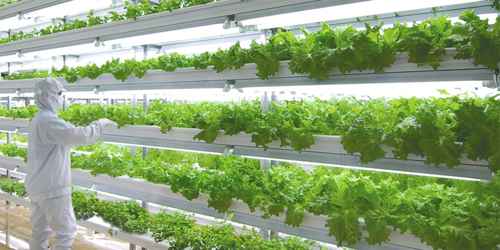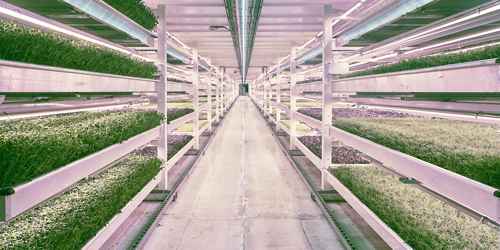Vertical farming or high-rise farming is a proposed indoor, urban farming technology involving large-scale agricultural production in multi-story buildings. Vertical farming is the practice of growing produce in vertically stacked layers. The practice can use soil, hydroponic or aeroponic growing methods. Vertical farms attempt to produce food in challenging environments, like where arable land is rare or unavailable. It is an intensive farming strategy which mainly employs advanced techniques such as hydroponics and aeroponics to produce crops like fruits, vegetables and edible mushrooms continuously. It also includes the raising of livestock and fishes indoor.

Vertical farming is a common method of growing produce in an indoor environment (e.g., a building or walk-in container) with carefully controlled conditions and lighting. Some vertical farms have conditions similar to greenhouses, using natural sunlight and primarily solar heating during the day. Other vertical farms are completely indoors, using artificial lighting and humidity and heating controls.
Lettuce, kale, and other forms of greens are the most common vegetables grown in vertical farms. Some crops like corn or grain just are not practical for this form of agriculture.
HOW IT WORKS
Vertical farming is more than producing food indoors in an urban landscape. It’s a proposed answer to the pending food crisis our world is facing. Despommier describes vertical farming as a system “in which a wide variety of produce is harvested in quantity enough to sustain even the largest of cities without significantly relying on resources beyond the city limits.”
In theory, these farms would be entirely self-sufficient, taking energy from the sun and wind, as well as composting spent plants to produce energy. Used water would even be recycled back into the system, saving more water for personal use. This system would not only grow crops year-round, but also raise livestock, such as poultry and pigs, to meet the needs of the growing urban population.

Types
Vertical farms come in different shapes and sizes, from simple two-level or wall-mounted systems to large warehouses several stories tall. But all vertical farms use one of three soil-free systems for providing nutrients to plants—hydroponic, aeroponic, or aquaponic.
Hydroponics. The predominant growing system used in vertical farms, hydroponics involves growing plants in nutrient solutions that are free of soil. The plant roots are submerged in the nutrient solution, which is frequently monitored and circulated to ensure that the correct chemical composition is maintained.
Aeroponics. An aeroponic system is by far the most efficient plant-growing system for vertical farms, using up to 90% less water than even the most efficient hydroponic systems. Plants grown in these aeroponic systems have also been shown to uptake more minerals and vitamins, making the plants healthier and potentially more nutritious.
Aquaponics. An aquaponic system takes the hydroponic system one step further, combining plants and fish in the same ecosystem. Fish are grown in indoor ponds, producing nutrient-rich waste that is used as a feed source for the plants in the vertical farm. The plants, in turn, filter and purify the wastewater, which is recycled to the fish ponds.
Advantages:
- Totally organic: The closed and controlled environment means there would be no insects, weeds or fungus to combat with chemicals. Pesticides, herbicides, fungicides and chemical fertilizers would be a thing of the past.
- The system is closed and protected. There’s no risk of losing crops to insect infestations, fungus, bacteria, weeds, drought, floods, snap freezes or natural disasters.
- More efficient: less energy and space used to grow more crops.
- No toxic water runoff polluting waterways.
- Less land used, 1 acre in vertical farming = 4-6 acres of land.
- Vertical farms would use 70% less water than traditional farming.
Disadvantages:
- Cost of production: A skyscraper-sized vertical farm would cost hundreds of millions of dollars to build and equip for agricultural needs.
- Cost of maintenance: Urban property is much more costly than rural property, and the cost to run thousands of LED lights, keep the temperature perfectly ambient and supply water to plants will outweigh the cost to run a traditional farm unless they can find a way to make the energy renewable and self-sustaining.
Information Sources:
















